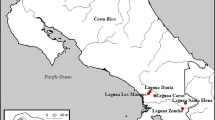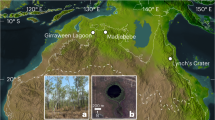Abstract
The neotropical Gran Sabana region of Venezuela is dominated by apparently anomalous vegetation types, treeless savannas and savanna-forest mosaics, considering the present-day warm and wet bioclimatic conditions. Past climatic changes and fire have been proposed as the more probable causes. Recent palynological studies show that savanna vegetation has been present since the beginning of the Holocene, but the earliest fires recorded so far only go back to 3,800 cal years b.p. This paper uses pollen and charcoal analyses to show the existence of early Holocene regional fires in the Gran Sabana, and to show the intimate connection between the proxies for fire (charcoal) and savanna vegetation (pollen) throughout the Holocene. Although the cause of such fires is not yet known, the possibility of early Holocene human occupation of the Gran Sabana is suggested.



Similar content being viewed by others
References
Beard JS (1953) The savanna vegetation of northern tropical America. Ecol Monogr 23:149–215
Behling H (2007) Late quaternary vegetation, fire and climate dynamics of Serra do Araçatuba in the Atlantic coastal mountains of Paraná State, southern Brazil. Veget Hist Archaeobot 16:77–85
Behling H, Hooghiemstra H (1998) Late quaternary palaeoecology and palaeoclimatology from pollen records of the savannas in the Llanos orientales in Colombia. Paleogeogr Paleoclimatol Paleoecol 139:251–267
Behling H, Hooghiemstra H (1999) Environmental history of the Colombian Savannas of the Llanos Orientales since the last glacial maximum from lake records El Pinal and Carimagua. J Paleolimnol 21:461–476
Behling H, Hooghiemstra H (2001) Neotropical savanna environments in space and time: late quaternary interhemispheric comparisons. In: Markgraf V (ed) Interhemispheric climate linkages. Academic Press, San Diego, pp 307–323
Bennett KD (1996) Determination of the number of zones in a biostratigraphical sequence. New Phytol 132:155–170
Bennett KD (2005) Documentation for psimpoll 4.25 and pscomb 1.03, C programs for plotting pollen diagrams and analysing pollen data. Department of Earth Sciences, University of Uppsala
Boyd M (2002) Identification of anthropogenic burning in the paleoecological record of northern prairies: a new approach. Ann Assoc Am Geog 93:471–487
Bush MB, Weng C (2007) Introducing a new (freeware) tool for palynology. J Biogeogr 34:377–380
Bush MB, Silman MR, Listopad CMCS (2007) A regional study of Holocene climate change and human occupation in Peruvian Amazonia. J Biogeogr 34:1342–1356
Colinvaux PA, De Oliveira PE, Moreno JE (1999) Amazon pollen manual and atlas. Harwood Academic Publishers, Amsterdam
Colson AB (1985) Routes of knowledge, an aspect of regional integration in the circum-Roraima area of the Guayana Highlands. Antropológica 63/64:103–149
Duffin KI, Gillson L, Willis KJ (2008) Testing the sensitivity of charcoal as an indicator of fire events in savanna environments: quantitative predictions of fire proximity, area and intensity. Holocene 18:279–291
Fölster H (1986) Forest-savanna dynamics and desertification processes in the Gran Sabana. Interciencia 11:311–316
Fölster H (1992) Holocene autochthonous forest degradation in southeast Venezuela. In: Goldhammer JG (ed) Tropical forests in transition. Birkhäuser, Berlin, pp 25–44
Fölster H, Dezzeo N (1994) La degradación de la vegetación. Scientia Guayanae 4:145–186
Gassón RA (2002) Orinoquia: the archaeology of the Orinoco river basin. J World Prehist 16:237–311
Haug GH, Hughen KA, Sigman DM, Peterson LC, Röhl U (2001) Southward migration of the intertropical convergence zone through the Holocene. Science 293:1304–1308
Hernández L (1999) Caracterización florística de los bosques. Scientia Guayanae 9:53–83
Huber O (1995a) Geographical and physical features. In: Berry PE, Holst BK, Yatskievych K (eds) Introduction. Flora of the Venezuelan Guayana, vol 1. Missouri Botanical Garden Press, St Louis, pp 1–61
Huber O (1995b) Vegetation. In: Berry PE, Holst BK, Yatskievych K (eds) Introduction. Flora of the Venezuelan Guayana, vol 1. Missouri Botanical Garden Press, St Louis, pp 97–160
Huber O (1995c) Conservation of the Venezuelan Guayana. In: Berry PE, Holst BK, Yaskievych K (eds) Introduction. Flora of the Venezuelan Guayana, vol 1. Missouri Botanical Garden Press, St Louis, pp 193–218
Kaplan MR, Wolfe AP (2006) Spatial and temporal variability of Holocene temperature in the north Atlantic region. Quat Res 65:223–231
Kaufman DS, Ager TA, Anderson NJ, Anderson PM, Andrews JT, Bartlein PJ, Brubaker LB, Coats LL, Cwynar LC, Duvall ML, Dyke AS, Edwards M, Eisner WR, Gajewski K, Geirsdóttir A, Hu FS, Jennings AE, Kaplan MR, Kerwin MW, Lozhkin AV, MacDonald GM, Miller GH, Mock CJ, Oswald WW, Otto-Bliesner BL, Porinchu DF, Rühland K, Smol JP, Steigd EJ, Wolfe BB (2004) Holocene thermal maximum in the western Arctic (0–180º W). Quat Sci Rev 23:529–560
Kingsbury ND (2001) Impacts of land use and cultural change in a fragile environment, indigenous acculturation and deforestation in Kavanayén, Gran Sabana, Venezuela. Interciencia 26:327–336
Lea DW, Pak DK, Peterson LC, Hughen KA (2003) Synchroneity of tropical and high-latitude Atlantic temperatures over the last glacial termination. Science 301:1361–1364
Reimer PJ, Baillie MGL, Bard E, Bayliss A, Beck JW, Bertrand CJH, Blackwell PG, Buck CE, Burr GS, Cutler KB, Damon PE, Lawrence R, Edwards RL, Fairbanks RG, Friedrich M, Guilderson TP, Hogg AG, Hughen KA, Kromer B, McCormac G, Manning S, Ramsey CB, Reimer RW, Remmele S, Southon JR, Stuiver M, Talamo S, Taylor FW, Van der Plicht J, Weyhenmeyer CE (2004) IntCal04 terrestrial radiocarbon age calibration, 0–26 cal kyr BP. Radiocarbon 46:1029–1057
Richards PW (1952) The tropical rain forest. Cambridge University Press, Cambridge
Rinaldi M, Schubert C (1991) Aspectos paleoclimáticos y su possible relación con la ocupación humana en la Gran Sabana, Escudo de Guayana, Venezuela: informe preliminar. Antropológica 75(76):127–140
Rinaldi M, Rull V, Schubert C (1990) Análisis paleoecológicos de una turbera en la Gran Sabana (Santa Cruz de Mapaurí), Venezuela, Resultados preliminares. Acta Cient Venez 41:66–68
Robinson GS, Burney LP, Burney DA (2005) Landscape paleoecology and megafaunal extinction in southeastern New York State. Ecol Monogr 75:295–315
Rodríguez I (2004) Conocimiento indígena vs científico: El conflicto por el uso el fuego en el Parque Nacional Canaima, Venezuela. Interciencia 29:121–129
Rodríguez I (2007) Pemon perspectives of fire management in Canaima National Park, Southeastern Venezuela. Human Ecol 35:331–343
Roubik DW, Moreno JE (1991) Pollen and spores of Barro Colorado Island. (Monographies in Systematic Botany 36) Missouri Botanical Garden, St Louis
Rull V (1987) A note on pollen counting in palaeoecology. Pollen Spores 29:471–480
Rull V (1992) Successional patterns of the Gran Sabana (southeastern Venezuela) vegetation during the last 5000 years, and its responses to climatic fluctuations and fire. J Biogeogr 19:329–338
Rull V (1999) A palynological record of a secondary succession after fire in the Gran Sabana, Venezuela. J Quat Sci 14:137–152
Rull V (2003) An illustrated key for the identification of pollen from Pantepui and the Gran Sabana (eastern Venezuelan Guayana). Palynology 27:95–129
Rull V (2007) Holocene global warming and the origin of the neotropical Gran Sabana in the Venezuelan Guayana. J Biogeogr 34:279–288
Salgado-Labouriau ML, Rull V (1986) A method of introducing exotic pollen for paleoecological analysis of sediments. Rev Palaeobot Palynol 47:97–103
Steyermark JA, Berry PE, Holst BK (eds) (1995–2005) Flora of the Venezuelan Guayana, vols 1–9. Missouri Botanical Garden, St Louis
Whitlock C, Larsen C (2001) Charcoal as fire proxy. In: Smol JP, Last WM (eds) Terrestrial, algal and siliceous indicators. Tracking environmental change using lake sediments, vol 3. Kluwer, Dordrecht, pp 75–97
Acknowledgments
This research has been supported by the Biodiversity Conservation Program of the BBVA Foundation (project BIOCON 2004-90/05), and the Ministry of Education and Science of Spain (project CGL2006-00974/BOS). Samples were provided by Milagro Rinaldi. The author acknowledges the comments of two anonymous referees and the managing editor, Lee Newsom, who contributed to the improvement of the manuscript.
Author information
Authors and Affiliations
Corresponding author
Additional information
Communicated by L. Newsom.
Rights and permissions
About this article
Cite this article
Rull, V. New palaeoecological evidence for the potential role of fire in the Gran Sabana, Venezuelan Guayana, and implications for early human occupation. Veget Hist Archaeobot 18, 219–224 (2009). https://doi.org/10.1007/s00334-008-0195-1
Received:
Accepted:
Published:
Issue Date:
DOI: https://doi.org/10.1007/s00334-008-0195-1




